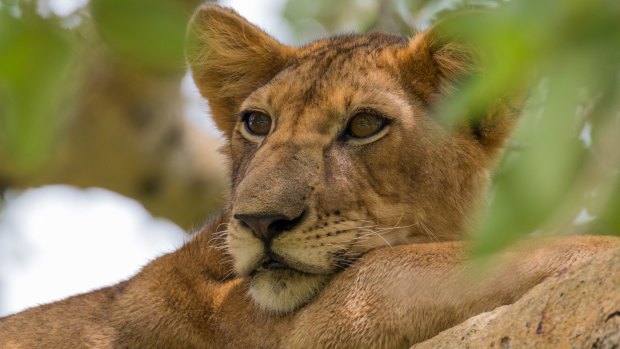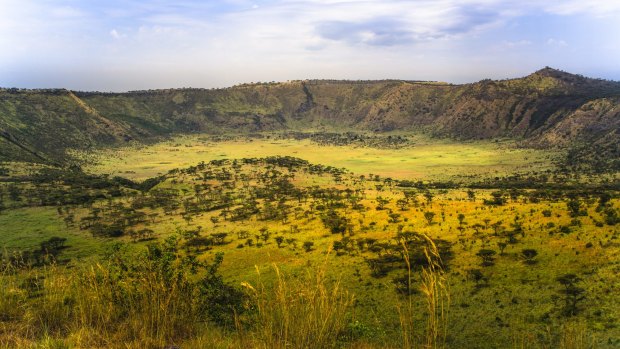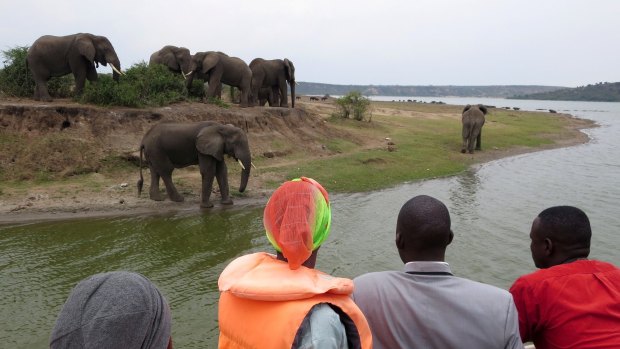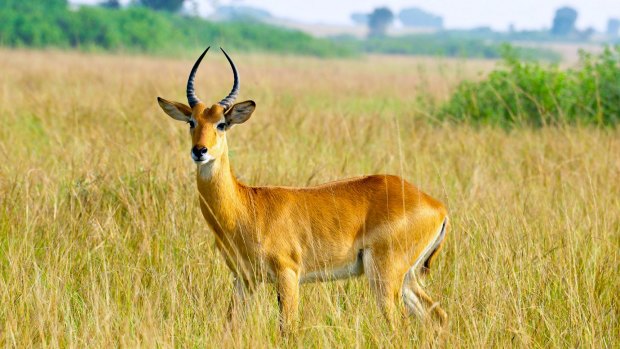This was published 7 years ago
Uganda wildlife adventure tour review: The astonishing Queen Elizabeth National Park

A lioness at rest.Credit: Shutterstock
Book a trip to Uganda and most people will assume you're going to see the mountain gorillas. It's one of only three places in the world where you can visit them in the wild (the others being Rwanda and the Congo). And while it's one of the most memorable wildlife encounters you'll ever have, Uganda has a lot more to offer nature enthusiasts. The country also has the infamous Big Five (lion, leopard, rhino, elephant and buffalo), 10 species of primates and more than a thousand varieties of birds.
Of Uganda's 10 national parks, the most visited is Queen Elizabeth National Park (QENP), a 1978-square-kilometre wildlife wonderland in the west of the country. Thanks to a volcanic landscape that includes savannahs, forests and wetlands, the park is home to an astonishing array of animal and bird life. It's also home to humans, too. It's one of the few national parks to have communities living inside its boundaries. All of which means there's an unusually diverse range of ways to experience it. Here are some of the best.
CRUISE CONTROL

Hippos in the Ishasha river, Queen Elizabeth National Park, Uganda.Credit: Shutterstock
"Please spread out and balance the boat," pleads Chalice as everyone rushes to the left-hand side to take photos.
Less than 10 metres away, a dozen elephants have come crashing out of the bush and are tentatively descending the muddy bank to the water's edge. We watch mesmerised as they patiently fill their trunks with water, then squirt it noisily into their open, smiling mouths.
One of QENP's defining features is the Kazinga Channel, a 32-kilometre-long waterway linking Lake George and Lake Edward. The channel's easy accessibility and gentle shoreline make it a magnet for wildlife, with animals coming to drink and bathe. The best way to observe this captivating spectacle is on a two-hour boat cruise from the Mweya Peninsula. Chalice is a guide from the Uganda Wildlife Association, the organisation that oversees all tourism activities in the park.

Craters in Queen Elizabeth National Park.Credit: Shutterstock
The boat is a rudimentary two-deck motor cruiser, with simple bench seats and an open-air viewing platform upstairs. Chalice's biggest challenge is preventing everyone from rushing to one side for photos, which sends the vessel into a precarious lean. As we proceed along the shoreline, we come across a large pod of wallowing hippos, their rounded backs like polished granite boulders. Behind them a group of four grizzled buffalo lie stoically in the shallows.
Chalice points out a lone crocodile, stone still and almost completely camouflaged by the grass and mud near the water's edge. Lions and leopards regularly come here to hunt, which you'd think would be a concern for the fishing community a few hundred metres away. But the residents seem unfazed when we pass, cheerily waving as they fix their nets and tend to their simple wooden boats. Chalice looks relieved when we turn around at the entrance to Lake Edward and head for home. His crowd control duties are done for today. For bookings, see ugandawildlife.org
GAME ON

Elephants in Queen Elizabeth National Park.Credit: Shutterstock.com
We watch with our hearts in our mouths as the first antelope tentatively creeps behind the ant hill. For the past 10 minutes the herd has been anxiously gathered on one side of the clearing – a nervous frenzy of twitching ears and tails as they look for a safe route to the other side. The reason for their concern? Sprawled out in the long grass in front of the ant hill is a sleeping male lion. At least, they hope he's sleeping.
Lions are just one of the drawcards during a game drive in QENP. The park is home to 95 mammals, including four of the Big Five (there are no rhino). The best viewing opportunities are on the grassy plains in the north of the park, where you're all but guaranteed good sightings of elephants, buffalo and warthogs. On this G Adventures-National Geographic Journeys trip, we have numerous encounters with these plus baboons and waterbucks but the big cats are more elusive.
During our two game drives we only see one lion and a leopard buried deep inside an acacia tree.

Elephants at the edge of the Kazinga Channel.Credit: Rob McFarland
While QENP can't match the big game experience of Kenya and South Africa, it makes up for it with scenic firepower. Framed by the spectacular Rwenzori Mountains, the park encompasses sweeping savannahs, dense forests and swampy marshlands. Punctuating this striking landscape are dozens of lake-filled craters, all evidence of the region's dramatic volcanic past. Even if you don't tick off every animal on your safari wish list, the search will be scenically spectacular regardless.
As for the antelope, to our slight disappointment, the herd makes it across the clearing intact. Fortunately for them, napping is the king of the jungle's priority today.
MONKEY BUSINESS

A Ugandan kob in Queen Elizabeth National Park.Credit: Shutterstock
It starts with a single, haunting, "Hoo hoo hoo …" but quickly escalates into a crescendo of ear-piercing screams. Above us there's a maelstrom of commotion as a fight breaks out between two male chimpanzees. Leaves and debris come crashing down as they career through the treetops at breakneck speed.
Eventually the loser hurtles down a tree to the ground, landing in the midst of our group, then scampers off into the undergrowth.
"Don't worry," says Rachel, our machete-wielding guide. "It's just an argument."
While it's possible to track chimpanzees in the Kyambura Gorge inside QENP, the chances of seeing them are slim, so G Adventures now includes this tour in neighbouring Kalinzu Forest Reserve instead. In addition to chimps, the reserve is also home to baboons, black and white colobus and three species of monkeys. Only one of the forest's six groups of chimps is habituated for human contact but thanks to a team of experienced trackers, there's an 85 per cent chance of seeing them.
It takes us 90 minutes to reach the group, following Rachel along narrow trails that meander through the dense forest. On the way she says the reserve is also home to 378 species of birds, 30 types of mammals (including the occasional leopard and lion who sneak in from QENP) plus an incredible 262 varieties of butterflies.
The group comprises 40 chimps and, during the 60 minutes we're permitted to spend with them, we see about a dozen, including an adorable wide-eyed baby who peers quizzically down at us from his mother's arms. The chimps mostly stay in the treetops so binoculars and a good zoom lens are essential. Aside from the "argument", we see chimps feeding, mating and grooming. While we peer skyward, Rachel explains their behaviours and social structures, including the hierarchy for mating and how they will occasionally hunt and eat other monkeys. On our way back we spot the losing male sitting on a branch looking subdued. "It's OK," Rachel says, smiling. "He'll be back with the group tomorrow."
BIRDER'S PARADISE
Thanks to its diverse range of habitats, QENP claims to have the most number of bird species of any east African national park. Eagled-eyed twitchers can potentially see more than 600 varieties. The park's lakes and waterways are home to a plethora of plovers, herons, pelicans and egrets while in the dense forest of the Kyambura Gorge you'll find cuckoos, woodpeckers and warblers. Particularly impressive are the thousands of flamingos that congregate in Lake Munyanyange between August and November.
For many birders, the ultimate thrill is to spot the elusive shoebill, a bizarre and menacing-looking stork with a razor-sharp, clog-shaped bill. Other notable species include the colourful great blue turaco and the crimson breasted papyrus gonolek. Bird walks with a UWA guide can be booked at the visitor centre on the Mweya Peninsula. See ugandawildlife.org
FIVE MORE WILDLIFE EXPERIENCES
MOUNTAIN GORILLAS
Coming face to face with a mountain gorilla is an indescribable thrill and Uganda's Bwindi Impenetrable National Park is one of only three places in the world where you can do it.
BATS AND PYTHONS
Hidden within the shady confines of the Maramagambo Forest in the south of QENP is a cave where you can observe fruit bats and the African rock pythons that feed on them.
TREE-CLIMBING LIONS
It's thought there are only two populations of tree-climbing lions in the world, one of which is in the Ishasha region in the south of QENP.
BIRDING ON THE NILE
For another chance to see the elusive shoebill, take a boat trip on the River Nile from Paraa in Murchison Falls National Park to the wildlife-rich shores of Lake Albert.
KYAMBURA GORGE
Although you'll have more chance of seeing chimps in Kalinzu Forest Reserve, this otherworldly gorge 100 metres below the Kichwamba escarpment in QENP is still worth visiting for its monkeys, giant forest hogs and wide range of African forest birds. See ugandawildlife.org
TRIP NOTES
MORE
FLY
Qatar and Emirates fly to Entebbe. See qatarairways.com; emirates.com
TOUR
G Adventures-National Geographic Journeys' nine-day Rwanda and Uganda Gorilla Discovery tour include treks to see mountain gorillas, golden monkeys and chimpanzees plus a cruise on the Kazinga Channel and two game drives in QENP. From $6623 a person. See gadventures.com.au
Rob McFarland travelled as a guest of G Adventures.
Sign up for the Traveller Deals newsletter
Get exclusive travel deals delivered straight to your inbox. Sign up now.